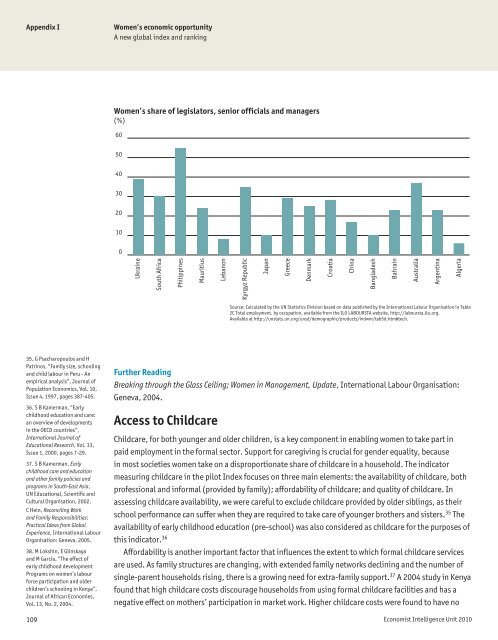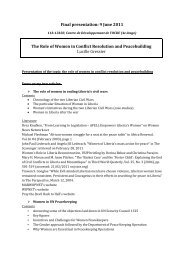Appendix IWomen’s economic opportunityA new global index and rankingWomen’s share of legislators, senior officials and managers(%)6050403020100UkraineSouth AfricaPhilippinesMauritiusLebanonKyrgyz RepublicJapanGreeceDenmarkCroatiaChinaBangladeshBahrainAustraliaArgentinaAlgeriaSource: Calculated by the UN Statistics Division based on data published by the International Labour Organisation in Table2C Total employment, by occupation, available from the ILO LABOURSTA website, http://laboursta.ilo.org.Available at http://unstats.un.org/unsd/demographic/products/indwm/tab5d.htm#tech.35. G Psacharopoulos and HPatrinos, “Family size, schoolingand child labour in Peru - Anempirical analysis”, Journal ofPopulation <strong>Economic</strong>s, Vol. 10,Issue 4, 1997, pages 387-405.36. S B Kamerman, “Earlychildhood education and care:an overview of developmentsin the OECD countries”,International Journal ofEducational Research, Vol. 33,Issue 1, 2000, pages 7-29.37. S B Kamerman, Earlychildhood care and educationand other family policies andprograms in South-East Asia,UN Educational, Scientific andCultural Organisation, 2002.C Hein, Reconciling Workand Family Responsibilities:Practical Ideas from GlobalExperience, International LabourOrganisation: Geneva, 2005.38. M Lokshin, E Glinskayaand M Garcia, “The effect ofearly childhood developmentPrograms on women’s labourforce participation and olderchildren’s schooling in Kenya”,Journal of African Economies,Vol. 13, No. 2, 2004.Further ReadingBreaking through the Glass Ceiling; Women in Management, Update, International Labour Organisation:Geneva, 2004.Access to ChildcareChildcare, for both younger and older children, is a key component in enabling women to take part inpaid employment in the formal sector. Support for caregiving is crucial for gender equality, becausein most societies women take on a disproportionate share of childcare in a household. The indicatormeasuring childcare in the pilot <strong>Index</strong> focuses on three main elements: the availability of childcare, bothprofessional and informal (provided by family); affordability of childcare; and quality of childcare. Inassessing childcare availability, we were careful to exclude childcare provided by older siblings, as theirschool performance can suffer when they are required to take care of younger brothers and sisters. 35 Theavailability of early childhood education (pre-school) was also considered as childcare for the purposes ofthis indicator. 36Affordability is another important factor that influences the extent to which formal childcare servicesare used. As family structures are changing, with extended family networks declining and the number ofsingle-parent households rising, there is a growing need for extra-family support. 37 A 2004 study in Kenyafound that high childcare costs discourage households from using formal childcare facilities and has anegative effect on mothers’ participation in market work. Higher childcare costs were found to have no109 <strong>Economist</strong> <strong>Intelligence</strong> <strong>Unit</strong> 2010
Appendix IWomen’s economic opportunityA new global index and ranking39. J M Love, L Harrison, A Sagi-Schwartz, M H van Ijzendoorn,C Ross, J A Ungerer, H Raikes, CBrady-Smith, K Boiler, J Brooks-Gunn, J Constantine, E EliasonKisker, D Paulsell and R Chazan-Cohen, “Child Care Quality Matters:How Conclusions May Vary withContext”, Child Development, Vol.74, No. 4, July/August 2003, pages1021-1033.J Belsky, “Early child care andearly child development: Majorfindings of the NICHD study of earlychild care”, European Journal ofDevelopmental Psychology, Vol. 3,Issue 1, March 2006, pages 95-110.40. D Blau, The Child Care Problem,Russell Sage Foundation: NewYork, 2001.41. A Chevalier and T K Viitanen,“The causality between femalelabour force participation and theavailability of childcare”, Applied<strong>Economic</strong>s Letters, Vol. 9, Issue 14,2002, pages 915-918.C M Herbs, B S Barnow, “Close toHome: A Simultaneous EquationsModel of the Relationship BetweenChild Care Accessibility and FemaleLabour Force Participation”,Journal of Family and <strong>Economic</strong>Issues, Vol. 29, No. 1, March 2008.42. F Jaumotte, Labour forceparticipation of women: Empiricalevidence on the role of policyand other determinants in OECDcountries. OECD <strong>Economic</strong> Studies,No. 37, 2003/2.43. Hein, op. cit.44. J Heymann, How are workerswith family responsibilities faringin the work place?, InternationalLabour Organisation: Geneva,2004. Also Kamerman (2002),op. cit.45. R Deutsch, “Does Child CarePay?: Labour Force Participationand Earnings Effects of Accessto Child Care in the Favelas ofRio de Janeiro”, Inter-AmericanDevelopment Bank. Working PaperNo. 384, 1998.46. R P de Barros, P Olinto, T Lundeand M Carvalho, “The Impact ofFree Childcare on Women’s LaborForce Participation: Evidence fromlow-income neighborhoods in Riode Janeiro”, background paper forWorld Bank Regional Study: Genderin Latin America and the Caribbean:Linking Labor Market Outcomesand Intra-Household Dynamics,forthcoming.47. M Bruhn, “Female-owned firmsin Latin America: characteristics,performance, and obstaclesto growth”, Policy ResearchWorking Paper Series, World Bank:Washington DC, 2009.significant effect on boys’ schooling, but significantly lowered the number of girls in school. 38Finally, the average quality of childcare available was assessed qualitatively for the countries in the<strong>Index</strong> sample. The quality of childcare has been found to influence young children’s developmentaloutcomes, 39 although research in the US suggests that price drives demand for childcare services morethan quality. 40Lack of affordable, good-quality childcare might not prevent women from obtaining paid employmentaltogether, but it will restrict them from competing for jobs on an equal basis to men. Further, becausewomen are often the secondary earner, they are more likely than men to reduce employment whenchildcare needs arise. This creates a negatively self-reinforcing cycle. Recent research shows that womenparticipate more in the labour market if childcare is available, making it important to policymakersto think about how to increase the supply of quality childcare. 41 There is also empirical evidence thatchildcare subsidies raise female labour supply levels, 42 although this specific policy tool is not assessed inthe <strong>Index</strong>.In the absence of access to childcare, many women are forced to take their children to work with them.Hein cites survey data for Peru, Pakistan and ten African countries that suggest that 40% of motherstake young children with them while they work. 43 Apart from the potential danger to the health of thechild, having to provide their own childcare while working restricts the range of jobs that mothers mayseek. Alternatively, children are left in the care of older female siblings, limiting girls’ opportunities toattend school, and thus restricting their opportunities in the future. 44 Heymann—based on extensive casestudies in Botswana, Guatemala, Mexico, Vietnam and the US—finds that lack of childcare is an importantfactor that pushes mothers from formal into informal employment.One of the few studies directly estimating the impact of childcare on women’s labour force participationand earnings, in Rio de Janeiro, confirms that “increased earnings are consistently associated with useof childcare outside the home”. 45 Deutsch’s findings suggest, however, that lack of flexibility and thelimited opening hours of publicly provided childcare significantly restricts the impact on women’s earningcapacity. Another recent randomised impact evaluation of public child day care on women’s labour marketbehaviour in Rio de Janeiro found that access to public childcare seems to increase significantly femalelabour force participation, especially for women not previously working. 46In terms of female entrepreneurship, a recent paper finds a negative correlation in Latin Americabetween childcare and household obligations on the one hand, and female-owned firm size andperformance on the other. 47 Data from Mexico and Bolivia also indicate that women are two to three timesmore likely than men to operate a business from their home. This suggests that household obligationscould be restricting the location, size and industry choices of female entrepreneurs.Further readingPierre Lefebvre, Philip Merrigan and Matthieu Verstraete, “Dynamic Labour Supply Effects of ChildcareSubsidies: Evidence from a Canadian Natural Experiment on Low-Fee Universal Childcare”, WorkingPaper 08-24, Centre interuniversitaire sur le risque, les politiques économiques et l’emploi: Montreal,September 2008.110 <strong>Economist</strong> <strong>Intelligence</strong> <strong>Unit</strong> 2010




